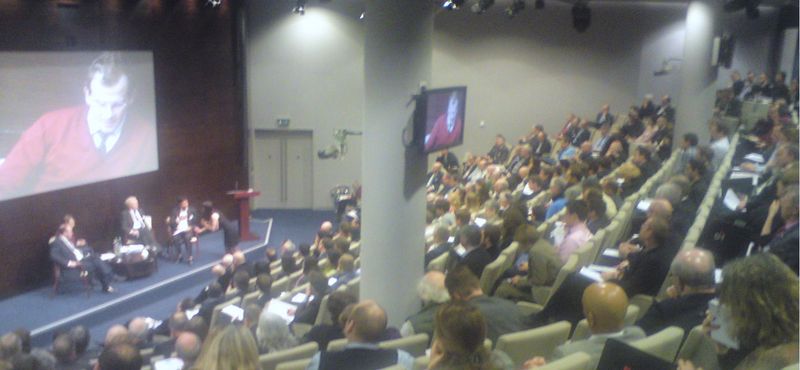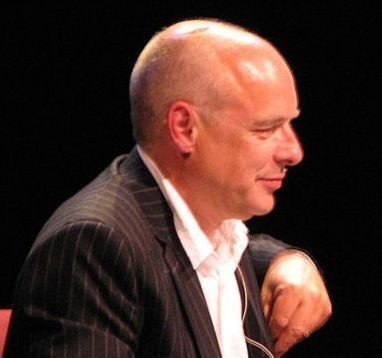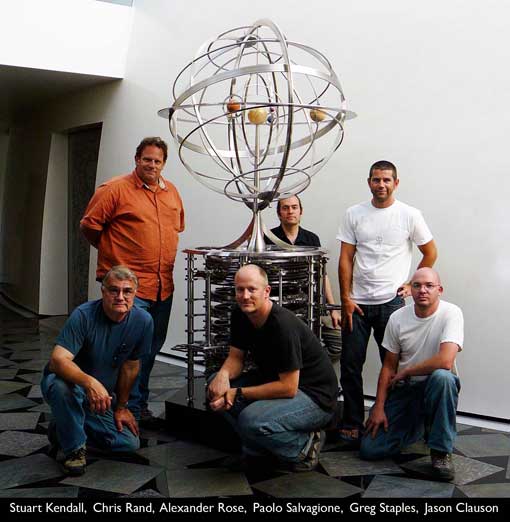
So I finally got to attend a free lunch!
This was the launch of the largest event focused upon using long-term thinking in finance that I’ve ever seen, and sponsored by many organisations including the Financial Services Club.

Around 400 folks gathered to hear the wise words of legendary thinkers and speakers, including my good friends Professor Michael Mainelli of Z/Yen Group and Bernard Lietaer, along with luminaries Brian Eno (yes, he from daze of old Roxy Music), Alexander Rose, Stewart Brand, Professor Sir Roderick Floud and fund manager Edward Bonham Carter.
This was all ably chaired by Faisal Islam from Channel 4 News.
The gathering will be a source of material for quite a while but, to begin with, it’s worth discussing the opening session, a panel discussing: "The Long Now - Long-Term Thinking and Responsibility In The Framework Of The Next 10,000 Years".
What the hell is it all that about, you may ask. 10,000 years? Who the hell cares about 10,000 years?
Well, a lot of folks do and the Long Now is all about thinking for the long-term.
Brian Eno kicked off the session by talking about how the idea came to him, as he is the man everyone pointed to as the creater of the phrase: “the Long Now”.

He said the idea came to him when walking around New York and seeing everyone rushing about, real fast.
New York – like many capital cities of today – is all about fast.
Fast this, fast that.
And everyone is passing through, as they don’t see New York as their home but as their place of work. So they have very short-term thinking or, as Brian referred to it, they think like a "Short Man".
Ask the Short Man what he’s doing, and he’ll tell you his plan for today or this week. That’s as far as the Short Man thinks. There is no life plan, or after life plan. Just the Short Now.
The issue however, as anyone thinking about what planet we will be leaving to our children and grand children and great grandchildren, is that short-term thinking is killing the planet. So how do we think long term: the Long Now?
It’s challenging.
10,000 years from now is 12010 AD (which is why all the material of the Long Now refers to Now years with a 0 precursor; for example, this year is 02010).
10,000 years ago was 7990 BC.
There was no civilisation as such then. We had just converted from cavemen to men in caves and beaches and nomadics. Then, around 5000 BC, we became civilised (which is debatable).
10,000 years is hard to imagine or to see as relevant.
So what did the Long Now guys do to make it seem more relevant?
After all, the aim is to get us to think about what we will be leaving on this planet for the long-term, not just today.
The Long Now guys decided to build a clock that would last for 10,000 years.

This would be a physical manifestation of the Long Now to inspire long-term thinking about what we leave on this planet.
The Clock was inspired by Danny Hillis, who had just created the world’s fastest computer back in the early 1990s, and it is a physical manifestation of the longness of time.
A clock that will last for 10,000 years.
The first question is how can you build a clock that will last that long?
And Danny responded by creating five guiding principles:
- Longevity: with occasional maintenance, the clock should reasonably be expected to display the correct time for the next 10,000 years.
- Maintainability: the clock should be maintainable with bronze-age technology.
- Transparency: it should be possible to determine operational principles of the clock by close inspection.
- Evolvability: it should be possible to improve the clock with time.
- Scalability: it should be possible to build working models of the clock from table-top to monumental size using the same design.
The five principles can easily apply to anything you want to build for the long term.
The Long Now team then built a prototype of the Clock in 1999, and are now building a massive underground 10,000 year clock in Nevada.
The clock has a really impressive algorithm which produces a different order for the ringing of the chimes each and every day for the next 10,000 years. That’s over 3.5 million combinations of chimes!
Amazing stuff.
All in all, the Long Now is very impressive. It’s also very academic, very expensive and very, very, very long-term, which raises the question ... so what?
OK, so it’s a big underground long now clock, but what’s it there for?
It’s there to get us to think about and answer long-term questions such as, what will happen to the clock if, in 1000 years, there’s another Dark Age?
It’s to get people to think long-term, which is what many are claiming we should now be doing in banking and finance.
And that was the point of this conference.
How can we think long?
I’ll add more to this entry through the week in bite-size chunks but, for sheer imagination, I like the idea of a 10,000 year clock.
Now, how about an Apple product that stays cool for more than one year?
Chris M Skinner
Chris Skinner is best known as an independent commentator on the financial markets through his blog, TheFinanser.com, as author of the bestselling book Digital Bank, and Chair of the European networking forum the Financial Services Club. He has been voted one of the most influential people in banking by The Financial Brand (as well as one of the best blogs), a FinTech Titan (Next Bank), one of the Fintech Leaders you need to follow (City AM, Deluxe and Jax Finance), as well as one of the Top 40 most influential people in financial technology by the Wall Street Journal's Financial News. To learn more click here...

